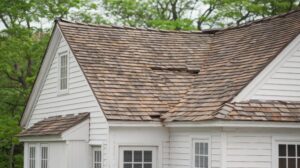 Choosing the right roofing material is a big decision. Whether you’re building a new home or replacing an aging roof, your choice can affect everything from curb appeal to energy efficiency—not to mention how well your home stands up to the unpredictable weather we get here in Upstate South Carolina. At Southern Comfort Exteriors, one of the most common questions we hear is: What’s the difference between three-tab shingles and architectural shingles—and which one should I choose?
Choosing the right roofing material is a big decision. Whether you’re building a new home or replacing an aging roof, your choice can affect everything from curb appeal to energy efficiency—not to mention how well your home stands up to the unpredictable weather we get here in Upstate South Carolina. At Southern Comfort Exteriors, one of the most common questions we hear is: What’s the difference between three-tab shingles and architectural shingles—and which one should I choose?
Let’s break it down.
[H2] What Are Three-Tab Shingles?
Three-tab shingles are the classic, traditional option for asphalt roofing. Each shingle strip is cut into three equal “tabs,” giving the roof a flat, consistent look. They’ve been used on homes across America for decades and are still a go-to choice for many budget-conscious homeowners.
[H3] Key Benefits of Three-Tab Shingles:
- Affordability: One of the most appealing aspects of three-tab shingles is their price. If you’re on a tighter budget, or if you’re preparing a home for resale or rental, this is a cost-effective option that still provides solid protection.
- Simplicity in Design: These shingles offer a clean, uniform look that works well with many traditional home styles.
- Lighter Weight: Because they’re made from a single layer of asphalt, they’re easier and quicker to install and place less strain on your roof decking.
[H3] Potential Drawbacks:
- Shorter Lifespan: On average, three-tab shingles last between 15 to 20 years, which is less than more premium materials.
- Lower Wind Rating: In areas like Spartanburg, Anderson, or Clemson where storms can bring heavy wind and rain, three-tab shingles may not hold up as well as more durable alternatives.
- Limited Design Options: The flat appearance doesn’t offer much in terms of visual dimension, which can be a drawback if curb appeal is a priority.
[H2] What Are Architectural Shingles?
Architectural shingles—also known as dimensional or laminated shingles—are a newer and more advanced option. They’re composed of multiple layers of asphalt fused together, creating a thicker, more durable shingle with a textured, high-end look. These shingles mimic the appearance of wood shakes or slate but without the associated cost or maintenance.
[H3] Advantages of Architectural Shingles:
- Long-Term Value: While the upfront cost is higher, architectural shingles often come with warranties of 30 years or more. That means fewer replacements and potentially fewer repairs over time.
- Superior Durability: Their multi-layered design makes them better equipped to handle high winds (often rated up to 130 mph), hail, and heavy rain—important for storm-prone regions like Upstate SC.
- Enhanced Curb Appeal: The dimensional look adds depth and sophistication, increasing your home’s resale value and visual appeal.
- Better Resistance to Algae: Many architectural shingles are manufactured with copper granules to resist algae growth—perfect for the humid, tree-lined neighborhoods in Greenville and Seneca.
A Few Considerations:
- Heavier Material: Because they are thicker and denser, these shingles may not be ideal for every roof structure unless it’s properly supported.
- Higher Cost: Though you’re getting a more durable and visually appealing product, the investment is larger up front.
[H2] Local Climate Considerations
Living in Upstate South Carolina means your home sees its fair share of seasonal challenges. From hot, humid summers to stormy spring evenings and occasional snow in the winter, your roof takes a beating. For homeowners in areas like Easley, Walhalla, and Boiling Springs, investing in roofing materials that can withstand moisture, heat, and high winds is critical.
Architectural shingles tend to perform better in these varying conditions thanks to their durability and weather resistance. They also provide better insulation, which can help lower your energy bills—especially during our long, hot Southern summers.
[H2] Aesthetic Differences That Matter
While both types of shingles are available in a range of colors, architectural shingles win when it comes to style and dimension. The layered construction creates a shadow effect that adds texture and richness to your roofline. For craftsman-style homes, modern farmhouses, or even traditional brick homes in places like Anderson or Pickens, this can elevate the entire exterior appearance.
On the other hand, if you’re restoring an older home or want to maintain a more uniform, simple aesthetic, three-tab shingles can offer that clean, timeless appeal without distraction.
[H2] Which One Offers Better ROI?
It all depends on your long-term goals. If you plan to stay in your home for the next 20–30 years, architectural shingles are likely the better investment. You’ll enjoy peace of mind knowing your roof can withstand severe weather and look great doing it.
If you’re selling your home, fixing up a rental property, or working within a strict budget, three-tab shingles can be a sensible choice that still improves your home’s appearance and function.
[H2] Expert Advice from Your Local Roofing Team
At Southern Comfort Exteriors, we know roofs—and we know the Upstate. We work with homeowners throughout the Greenville-Spartanburg-Anderson area to recommend roofing materials that not only fit their budgets but also perform well against South Carolina’s unique climate challenges.
Our expert team can inspect your current roof, explain the benefits of each option, and help you choose a shingle that offers the perfect blend of performance, aesthetics, and affordability.
[H3] Need help deciding between three-tab and architectural shingles?
Call Southern Comfort Exteriors today to schedule a free consultation. We proudly serve homeowners across Upstate SC—from the Foothills to the Fall Line—and we’re ready to bring comfort and confidence to your roof, one shingle at a time.